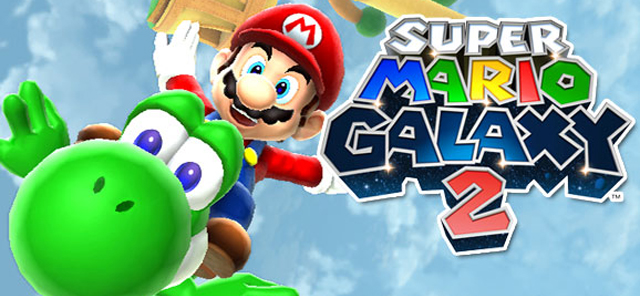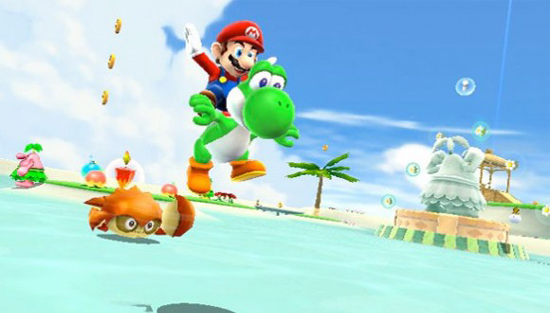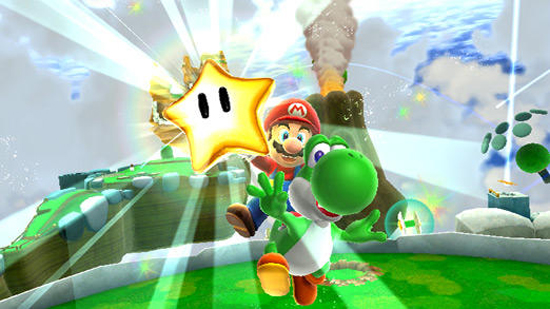Foreword: Just so nobody gets the wrong impression, I really like this CD. I just want to share my thoughts on it. Not all of them are nice. Thanks for understanding.
Among the many, many wonderful things Stephanie bought me that were amalgamated into my wedding gift (that girl spoils me rotten) was a compact disc entitled The Greatest Video Game Music. I can’t help but feel like maybe the London Philharmonic Orchestra was trying to start something with me there.
Calling your compilation The Greatest Video Game Music is setting the bar pretty high, as we video game nerds love us some video game musics. A cursory glance at the back of the cover confirmed my suspicions that it was something more akin to The Most Marketable Video Game Music. More evidence of this is that the image on the cover is a soldier with a cello on fire and a helicopter in the background. VIDEO GAMES ARE NOT ALL CALL OF DUTY. Goddammit. Stupid Sony and Activision ruined everything.
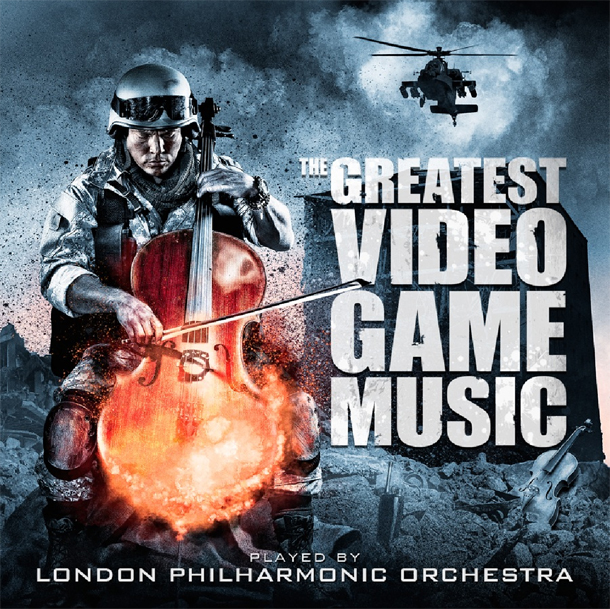
Anyway, that’s starting to deviate from my point. Or is it? I don’t know, I’m confused about where I was taking this. I guess something about how many games are represented on here that I didn’t even know had music, nevermind music that anybody bight consider to be the greatest. Oh, sure, you’ve got representation for the mainstays like Super Mario Bros, The Legend of Zelda, and Final Fantasy. There are a few you might not not think of off the cuff but definitely belong there, like the Metal Gear Solid 2: Sons of Liberty and Tetris themes (more on the latter in a bit). Then there’s… the rest.
“I didn’t even know ____ had music.” You can fill in that blank with any of the following games that are represented on this CD: Splinter Cell: Conviction, Fallout 3, Call of Duty 4: Modern Warfare, Modern Warfare 2, and Battlefield 2. There are a couple others in there that puzzled me, most notably Bioshock, Oblivion, and Mass Effect. I know that all of these games had music, but none of them had memorable music. Chalk that up to the games being so immersive that I didn’t notice music in the background if you must, but I couldn’t hum you a single tune from any of those titles. The tracks from these games didn’t even seem familiar to me when I listened to them, so that.
Back to that contingent of FPSs though. Is it really necessary to include tracks from both Modern Warfares and Battlefield 2? I can’t imagine that anyone who plays those games cares at all about the music in them. Same thing with Splinter Cell. They probably could have replaced at least two of those entries with something a little more fitting, say a track each from Sonic the Hedgehog 2 and MegaMan 2? You know, games with music that people actually care about. Maybe even too much in some cases. Halo 3‘s inclusion I give a pass because it’s just not a personal interest; I’ve heard many people laud the Halo soundtracks.
The two that really make me scratch my head are the tracks from Advent Rising and Angry Birds. I’ve never even heard of Advent Rising. And Angry Birds. Angry. Birds. Nobody but nobody who is going to buy this particular CD is in the Angry Birds demographic. Yes, I played it. But that was before I downloaded real games onto my phone. Is there even any music in Angry Birds past the title screen?
Uncharted, Grand Theft Auto IV, and World of Warcraft also seemed a little out of place to me. But at least those are gamers’ games and not paint-by-numbers FPSs.
So maybe I think the track selection could have used a little fine tuning. Of course I do. Every single (real) gamer who looks at this CD will have a whole lotta corrections to make. There are so many games out there with fantastic music that it would be impossible to pare it down to a mere 20ish tracks, even if you didn’t double-dip for a few franchises. The real question here is if the compilation that the London Philharmonic Orchestra chose works. The short answer is “Yes.”
The long answer, if you’re up for a few more paragraphs, is just a lot more music/game nerd over-analysis and picking. And the first thing that I want to say is that I hit the nail on the nose: the two Modern Warfare tracks and the Battlefield 2 theme are ultimately forgettable. Generic war-sounding tunes, mainly to a marching drum beat with some technoey stuff thrown in to try to differentiate them. Sorry, LPO, you shot too wide. Reign it in and play for the people who love video games, not the people who play shooting games because that’s the fad right now. Gamers love video game music, Bros do not. Not a single Bro will buy this album, and that is the hard truth of it.
The Advent Rising, Oblivion, Splinter Cell, Fallout 3 and Uncharted tracks didn’t make a mark on me. Its not that they were bad, it’s just that they didn’t stand out in any special way. They sound nice in my ears, but not so much that I’m ever going to have them buzzing through my head when my earbuds are out. The track included from Bioshock made me wonder why it was there, because it was more moody ambiance, and not actual music you might listen to independently. I can see why fans of the games might get into any of these tracks though.
You know, what? No. The Splinter Cell track wasn’t forgettable, it actually sounded kind of like it came out of Metal Gear Solid, just less grandiose. I consider that a compliment; MGS games usually have pretty solid soundtracks.
I was impressed by how much I enjoyed the Grand Theft Auto IV and World of Warcraft tracks. The GTAIV inclusion (“Soviet Connection”) isn’t particularly elaborate, but it’s got a punchy percussion line and some beautifully deep horns. The strings throughout lend the piece a real sense of gravitas and tie the whole thing tegether in a neat little bow. The WOW track (“Seasons of War”) works in a strong but not overstated vocal group, and works up from a very slow, somber start into an almost victorious melody before rolling back down into more of a battle theme that makes brief use of an almost tribal-sounding drum phrase. Again, it’s not big and flashy, but that’s probably what makes it so great.
The MGS2 theme is practically untouched, which is great because that track’s official form is perfect. The same goes for “Liberi Fatali” from Final Fantasy VIII. I guess the orchestral version varies a bit, but it hews quite closely to the original and that is just the way I like it. I was honestly a little disappointed that they didn’t do much in the was of arranging for Super Mario Galaxy‘s “Gusty Garden Galaxy,” because since it was recorded by an orchestra to begin with, a more elaborate arrangement would have been the best way to make it stand out. I love the song though; the string chorus alone is enough to put a big smile on my face.
That brings me to the set of songs that sit in a strange limbo between my opinion poles. “Super Mario Bros Themes”, “The Legend of Zelda Suite” and “Final Fantasy Main Theme” are all fantastic songs. So why was I kind of disappointed with their showing here? These are where the legacy of video game music really begins. These are the big three. It is not my place to question them.
I don’t know why, but I have a hard time appreciating hi-fi versions of the SMB theme. It just sounds wrong when played on anything more advanced than maybe a SNES sound chip. The LPO does a fine job with what they’ve got, but I guess I’d just rather they’d taken a piece from a more recent game. Nintendo doesn’t even re-use the original Mario theme all that often (in the main series), and when they do it’s in its natural state or heavily arranged so that it sounds okay without the blippity-bloopities. The underwater part sounds beautiful on strings, but the rest of the song was not meant for real instruments.
I’ve heard this particular Legend of Zelda suite before. I was sad because I wasn’t expecting a repeat. It’s still great though!
The Final Fantasy theme is a stirring string-based piece with some faint horns to give it a little body. It is the most beautiful track on the album. It is so deeply ingrained in my soul that sometimes I get a little misty-eyes when I hear it in a new FF game. What could I possibly have against it? I was secretly hoping it would be the Final Fantasy IV version of “Prelude”, which I like just a little bit more.
The most surprising tracks on the disc, I found, were those from Halo 3 and Mass Effect. Mass Effect especially because I’ve played through the game twice and never noticed the music at all. But if “Suicide Mission” can speak for the rest of the soundtrack, it must be amazing! The track starts of with a fairly simple beat, and then layers on instruments one by one, until it builds into an incredible “here we go to save the world” kind of thing. It’s deathly serious, but keeps your spirits up by mixing in some uplifting phrases into the generally foreboding melody. It’s perfectly suited to the atmosphere of Mass Effect, and I feel like I should give the game another round so that I can stop to appreciate its musical accompaniment.
As I said before, I expected pretty good things from the Halo 3 song, “One Final Effort,” and I was not at all disappointed. I thought it was really weird how much praise the Halo soundtracks get, but if the rest is as good as this single example, I might have to look into actually listening to the full soundtracks.
The brightest spot on this disc, however, comes totally out of left field both in the fact that I wasn’t expecting it to be my favourite track, and also because it starts way off from the source material. The Tetris theme, of all things, is apparently where the LPO decided to really show their stuff. It opens up with a peppy drum line, onto which other instruments gradually join, and then finally launches into a brief piano solo of the main riff. A horn comes in, and the drums return, then things just go out of control with the melodies and beats changing almost as much as the instrumentation. About three quarters of the way it slows down into a horn-driven waltz, and gradually picks up steam again in layered repetitions of the tune until the end.
Oddly enough, it kind of ends up sounding like it was arranged to fit into the Kirby’s Air Ride soundtrack.
Understandably, you kind of have to work with the Tetris theme to make it compelling. In its natural state, it’s repetitive and basic, not unlike Tetris itself. So it stands to reason that if you were going to have an orchestra play it, they’d probably want to do a little arranging. And this is great! The end product is marvelous! I’m just a little disappointed that the rest of the CD (or at least what I’m familiar with) didn’t take nearly as much creative license as this single song did. Granted, you might also argue that gamers want to hear the music they love in a format that they recognize, but there are entire communities based around remixing video game music. I really think it could work.
Anyway, I’ll stop talking about how this CD could be “better” now. It’s great the way it is. Maybe I haven’t gotten that through enough. It’s wonderful. I really like it. Big props to the London Philharmonic Orchestra for this one. If you’re going to buy an album of video game music as played by a major orchestra… well, I’ve never seen another one, but I’m sure this one measures up nicely to any others that could theoretically exist. There are certainly far worse ways to spend twentyish bucks.
I think if I’d seen it live I would have complained a lot less.

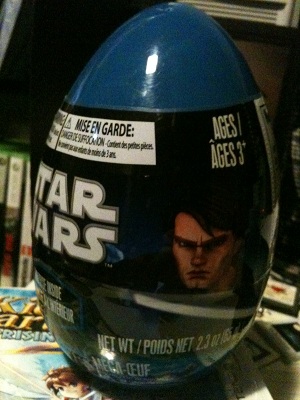
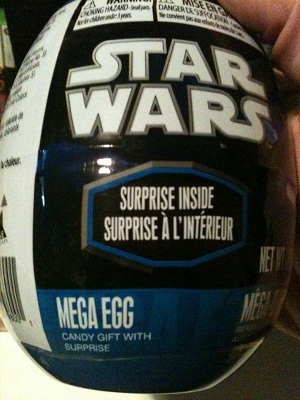
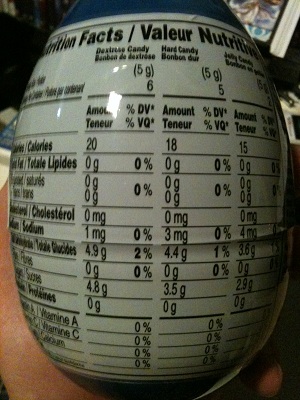
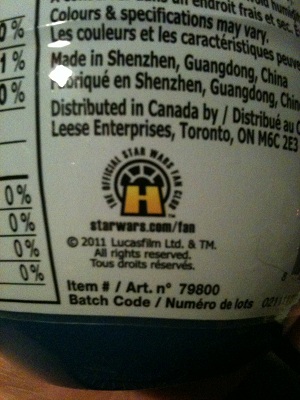
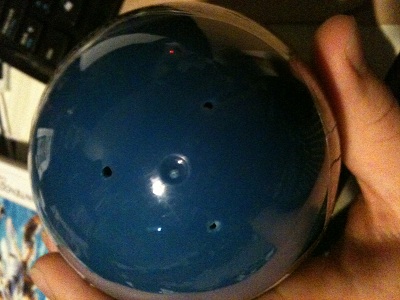
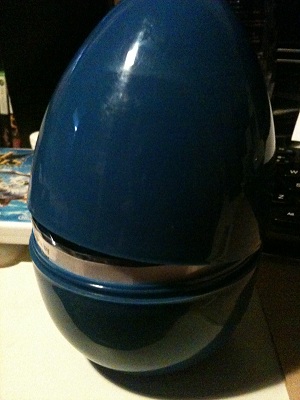
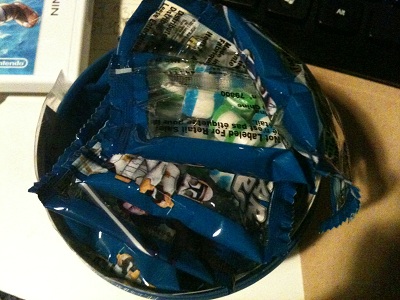
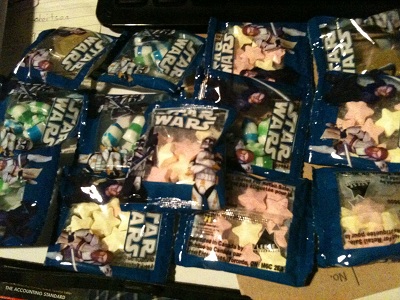
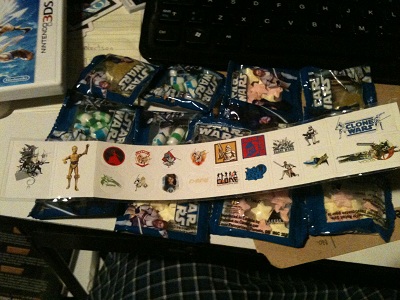
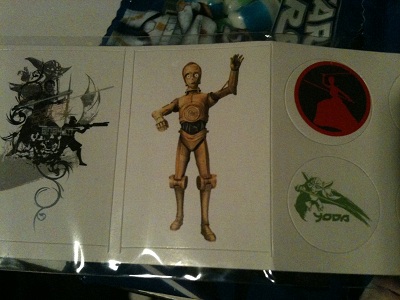
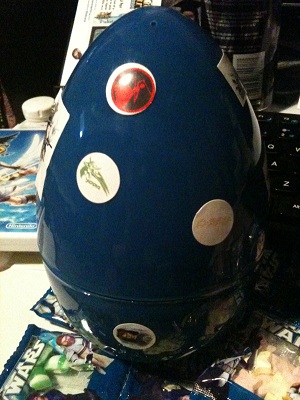
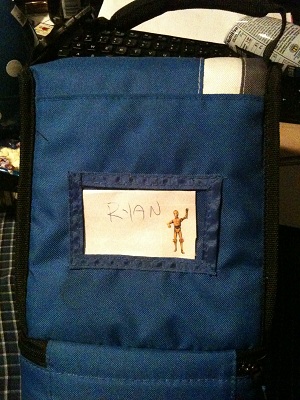
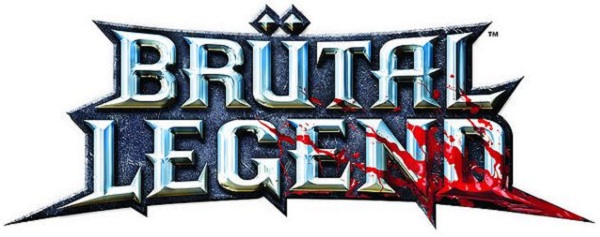 Brütal Legend is, in most cases, a swell game. “Just swell?” you ask, thinking that usually when I like a game, I have trouble using adjectives that aren’t “awesome.” But yes Brütal Legend, is only swell. And while many of its parts far exceed that and delve deep into the realm of the aforementioned awesome, the sum of those parts is maybe a little lacking. Now I bet you’re thinking that such a complicated summary of a game’s worth will require an even more complicated explanation. And I’d be glad to give you one!
Brütal Legend is, in most cases, a swell game. “Just swell?” you ask, thinking that usually when I like a game, I have trouble using adjectives that aren’t “awesome.” But yes Brütal Legend, is only swell. And while many of its parts far exceed that and delve deep into the realm of the aforementioned awesome, the sum of those parts is maybe a little lacking. Now I bet you’re thinking that such a complicated summary of a game’s worth will require an even more complicated explanation. And I’d be glad to give you one!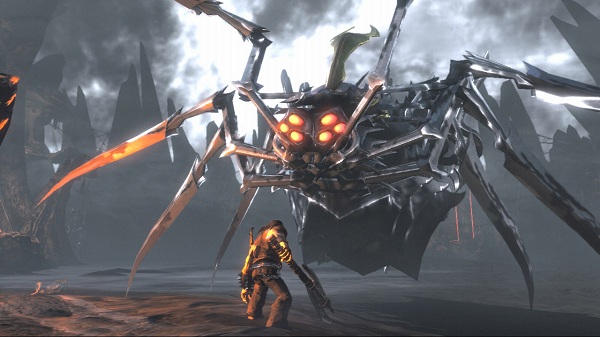 That love, to be specific, is for metal. And I’m not talking periodic table metal here. I mean the fastest, loudest, most genuine kind of music known to man. Tim Schaffer, the game’s creative director (and mind behind gems like The Secret of Monkey Island and Psychonauts), set out to make the ultimate video game tribute to heavy metal, and I don’t believe that (outside of Guitar Hero 2, perhaps) a better claim to the title exists. Brütal Legend’s world is maybe not as gigantic as some, but it’s certainly more interesting. Where other open-world video games feature fairly generic cities with little original scenery and only a handful of truly interesting things to see, the world of Brütal Legend was built specifically to catch your eye at every corner.
That love, to be specific, is for metal. And I’m not talking periodic table metal here. I mean the fastest, loudest, most genuine kind of music known to man. Tim Schaffer, the game’s creative director (and mind behind gems like The Secret of Monkey Island and Psychonauts), set out to make the ultimate video game tribute to heavy metal, and I don’t believe that (outside of Guitar Hero 2, perhaps) a better claim to the title exists. Brütal Legend’s world is maybe not as gigantic as some, but it’s certainly more interesting. Where other open-world video games feature fairly generic cities with little original scenery and only a handful of truly interesting things to see, the world of Brütal Legend was built specifically to catch your eye at every corner.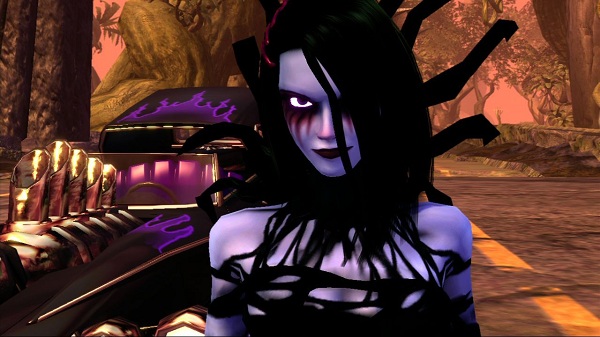 The other reason you’re going to take the time to roam the land is because of the Deuce’s Mouth of Metal. Or in layman’s terms: the radio. Brutal Legend has one of the best video game soundtracks that I’ve ever heard, right up on par with Guitar Hero 2 and Tony Hawk’s American Wasteland. Possibly even better. If you were to
The other reason you’re going to take the time to roam the land is because of the Deuce’s Mouth of Metal. Or in layman’s terms: the radio. Brutal Legend has one of the best video game soundtracks that I’ve ever heard, right up on par with Guitar Hero 2 and Tony Hawk’s American Wasteland. Possibly even better. If you were to 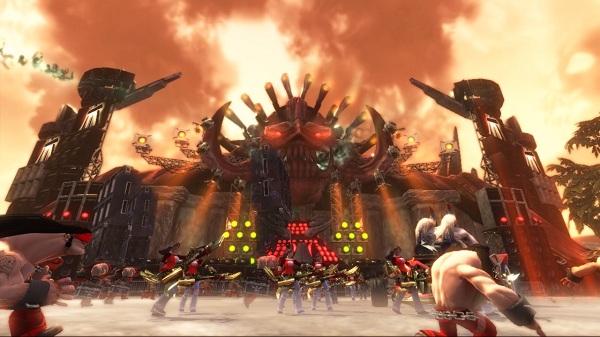 The bosses are one-on-one affairs (er… sort of, they can both summon minor enemies), and that’s why it kind of stumbles. Again, while on foot, Eddie’s combat controls aren’t great. They use a Zelda-esque lock-on system, but it feels unrefined and maybe less responsive than it should be. Enemies are also very resilient, and their attacks are rarely interrupted by hits. They also tend to track you as you dodge, so even if you get out of the way while they’re winding up for an attack, they might still end up facing you by the time it launches. These are huge issues when surrounded by baddies, which results in you taking a lot more damage than you should, but it’s not quite as bad mano-e-demono.
The bosses are one-on-one affairs (er… sort of, they can both summon minor enemies), and that’s why it kind of stumbles. Again, while on foot, Eddie’s combat controls aren’t great. They use a Zelda-esque lock-on system, but it feels unrefined and maybe less responsive than it should be. Enemies are also very resilient, and their attacks are rarely interrupted by hits. They also tend to track you as you dodge, so even if you get out of the way while they’re winding up for an attack, they might still end up facing you by the time it launches. These are huge issues when surrounded by baddies, which results in you taking a lot more damage than you should, but it’s not quite as bad mano-e-demono.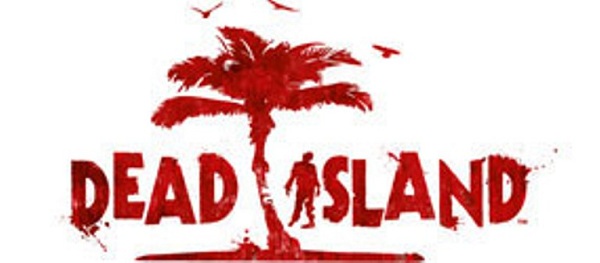 I’ve recently been spending large chunks of my weekends on Dead Island, and I’ve got pretty mixed feelings about it. For the tl;dr crowd: I like it, and I’m pretty sure that if you like Fallout 3 you’ll find much to enjoy here.
I’ve recently been spending large chunks of my weekends on Dead Island, and I’ve got pretty mixed feelings about it. For the tl;dr crowd: I like it, and I’m pretty sure that if you like Fallout 3 you’ll find much to enjoy here.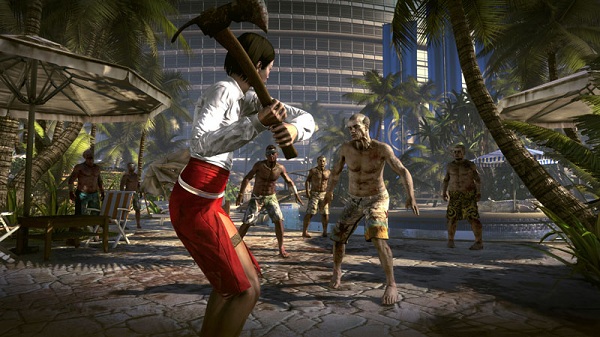
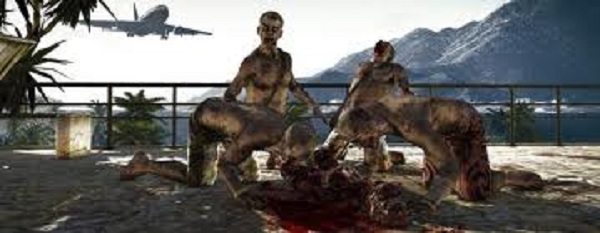 Outside of thugs though, removing limbs isn’t strictly necessary, as by the time you’ve got that second arm off, that zombie’s probably re-dead anyway. Decapitation, of course, is always your best bet. They’re zombies! And they’re scary! A lone zombie isn’t much trouble; you’re equipped with a kick move that almost guarantees knocking a ghoul down, and once they’re down, they’re meat. Though as I noted before, a bunch of zombies can easily tear you a new one. I don’t know how many times now I was poking around and got mobbed by a group of four or five zombies. It doesn’t sound like a lot, but they hit hard and flail around pretty quickly. Especially the “infected” class of zombies, who are Dead Island’s version of the Hollywood zombie. Not that classifying the fast ones as “infected” makes a lick of sense. Aren’t all of them infected? Isn’t that the problem?
Outside of thugs though, removing limbs isn’t strictly necessary, as by the time you’ve got that second arm off, that zombie’s probably re-dead anyway. Decapitation, of course, is always your best bet. They’re zombies! And they’re scary! A lone zombie isn’t much trouble; you’re equipped with a kick move that almost guarantees knocking a ghoul down, and once they’re down, they’re meat. Though as I noted before, a bunch of zombies can easily tear you a new one. I don’t know how many times now I was poking around and got mobbed by a group of four or five zombies. It doesn’t sound like a lot, but they hit hard and flail around pretty quickly. Especially the “infected” class of zombies, who are Dead Island’s version of the Hollywood zombie. Not that classifying the fast ones as “infected” makes a lick of sense. Aren’t all of them infected? Isn’t that the problem?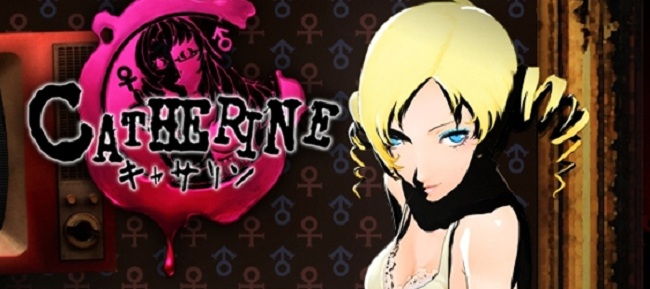
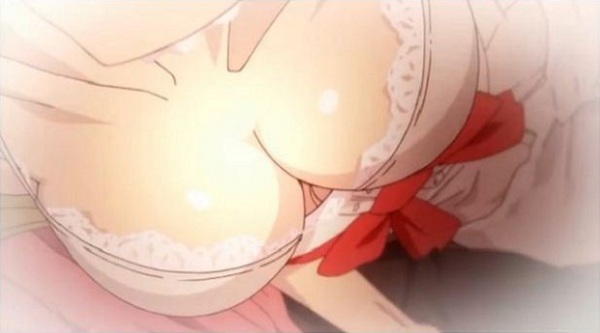
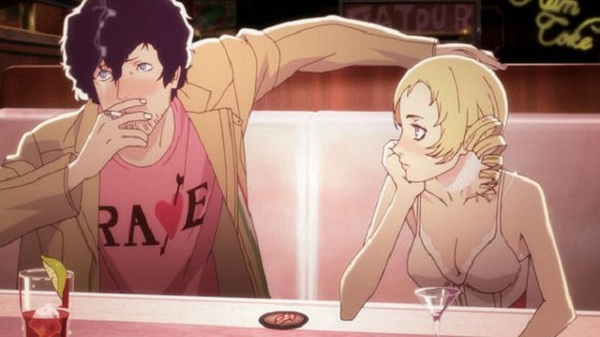
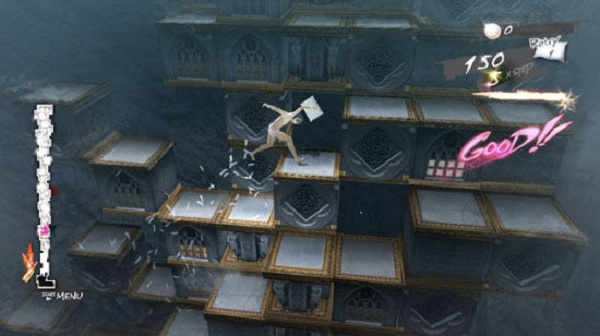
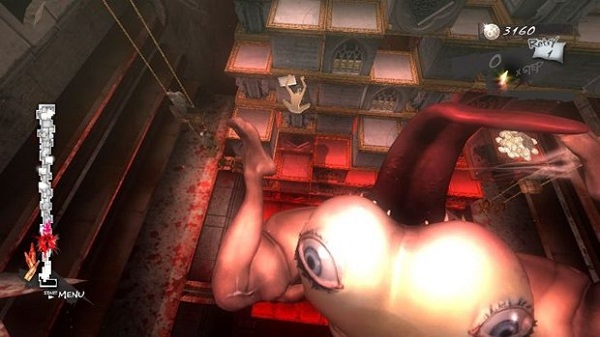
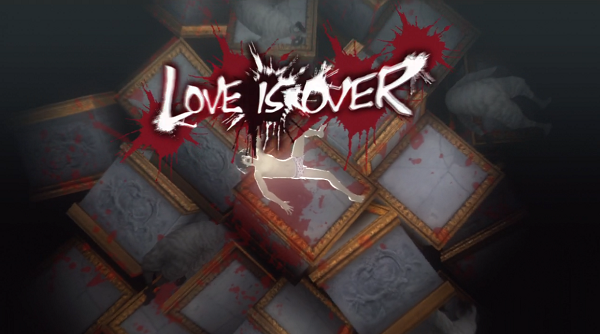

























 In both cases, where the fourth game in the series is concerned, the less said, the better. At this point in both series lifespans, the developers had openly admitted to wanting to milk their respective series for as much cash as they could while the games were at the peaks of their popularity. Battle Network 4 was a disaster. Not only was the main plot device a lame battle tournament, but you had to complete the asinine story three times to get everything. Each time you would play on the next difficulty, and unlock a new rank of chips and gear each time. It was awful, and I don’t believe I cared enough to make it through my second run, even though I’d stuck with both BN2 and 3 all the way to 100% completions. You don’t even get to see all the boss enemies until you’ve played through all three time. But that’s not so awful as it could be, because the bosses were starting to seem less like souped-up versions of classic MegaMan enemies, and more like big goofballs. The only nice thing I have to say is that at least here they gave the two versions very distinct differences, with a completely different set of bosses and transformations for MegaMan. It would have made playing both versions worthwhile if the game hadn’t been completely broken. And speaking of broken, I’m not even going to get into that whole Dark Chip mess.
In both cases, where the fourth game in the series is concerned, the less said, the better. At this point in both series lifespans, the developers had openly admitted to wanting to milk their respective series for as much cash as they could while the games were at the peaks of their popularity. Battle Network 4 was a disaster. Not only was the main plot device a lame battle tournament, but you had to complete the asinine story three times to get everything. Each time you would play on the next difficulty, and unlock a new rank of chips and gear each time. It was awful, and I don’t believe I cared enough to make it through my second run, even though I’d stuck with both BN2 and 3 all the way to 100% completions. You don’t even get to see all the boss enemies until you’ve played through all three time. But that’s not so awful as it could be, because the bosses were starting to seem less like souped-up versions of classic MegaMan enemies, and more like big goofballs. The only nice thing I have to say is that at least here they gave the two versions very distinct differences, with a completely different set of bosses and transformations for MegaMan. It would have made playing both versions worthwhile if the game hadn’t been completely broken. And speaking of broken, I’m not even going to get into that whole Dark Chip mess. Battle Network 6 scaled itself back down a bit in terms of ambition and diversity, but it was the closest the series has come to trumping BN2. The version split isn’t quite as huge as in the last two games, but each still contains a unique set of ally characters. And MegaMan’s transformation powers have been tweaked to be so much greater than ever, giving him his allies’ forms without time limits, a super-powerful standard Beast transformation, and nearly unstoppable Beast versions of each of the other forms. While BN6 drops the strategy sub-game, it allows you to play as the ally characters much more freely and all but removes the horrible, game-breaking Dark Chips. The story ends here, officially putting the series to bed, and I honestly was happy that it ended on such a good note. Had Battle Network 4 been the last one, it would have left a bad taste in my mouth that might have fouled my love for the older games in the series. But things got much better from there on in, and while 4 is best avoided and 5 is skippable, Battle Network 6 is definitely a chapter in the series that fans will enjoy. I know I was very pleased that I enjoyed the game to stick with it long enough to almost hit %100 completion again. I let a few of the higher-class chips go, but I essentially saw all that the game had to offer, and that’s way more than I got from 4 and 5.
Battle Network 6 scaled itself back down a bit in terms of ambition and diversity, but it was the closest the series has come to trumping BN2. The version split isn’t quite as huge as in the last two games, but each still contains a unique set of ally characters. And MegaMan’s transformation powers have been tweaked to be so much greater than ever, giving him his allies’ forms without time limits, a super-powerful standard Beast transformation, and nearly unstoppable Beast versions of each of the other forms. While BN6 drops the strategy sub-game, it allows you to play as the ally characters much more freely and all but removes the horrible, game-breaking Dark Chips. The story ends here, officially putting the series to bed, and I honestly was happy that it ended on such a good note. Had Battle Network 4 been the last one, it would have left a bad taste in my mouth that might have fouled my love for the older games in the series. But things got much better from there on in, and while 4 is best avoided and 5 is skippable, Battle Network 6 is definitely a chapter in the series that fans will enjoy. I know I was very pleased that I enjoyed the game to stick with it long enough to almost hit %100 completion again. I let a few of the higher-class chips go, but I essentially saw all that the game had to offer, and that’s way more than I got from 4 and 5.
